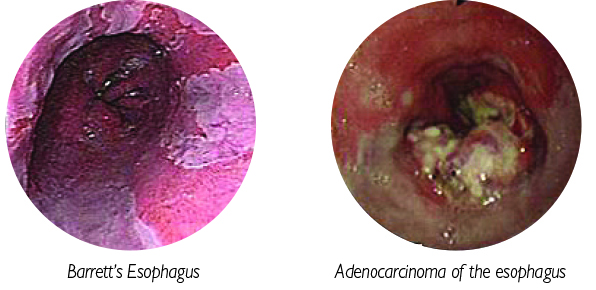|
Barrett’s Esophagus: Risks and TreatmentPaul Ruh, MD Do you or someone you know suffer from Heartburn?Heartburn is caused by Gastroesophageal Reflux Disease (GERD) and can be a sign of a very serious condition affecting the esophagus. People who have heartburn are at risk for developing a condition called Barrett’s Esophagus (Barrett’s). Barrett’s is best described as a change in the tissue type in the esophagus thought to arise as a defense by the body to protect from acid exposure related to GERD.
At first look this appears to be a good thing. However, Barrett’s is actually a precancerous condition that can lead to the development of esophageal cancer. The published risk of progression from Barrett’s Esophagus to cancer varies from study to study, but recently a study suggested that, if left untreated for 20 years, Barrett’s will develop into cancer in 9.1% to 9.5% of patients. The type of esophageal cancer associated with Barrett’s is called adenocarcinoma, and there is an alarming increase in the number of new cases of adenocarcinoma of the esophagus. It can occur in patients as early as 30 years old! The increased incidence is worse than melanoma and prostate cancer put together. We can only explain the increase by assuming that more patients with GERD are developing Barrett’s esophagus. Although there are strict guidelines for recommending screening upper endoscopy for patients with heartburn, these guidelines are often not followed. The most important step in preventing cancer in Barrett’s esophagus is to FIND the Barrett’s. An upper endoscopy (or sometimes called an EGD) is a simple, safe procedure done
with sedation aimed at examining the upper GI tract, including The guidelines call for a screening of EGD in:
When we find a patient with Barrett’s Esophagus, they begin a careful monitoring program involving periodic upper endoscopy by a gastroenterologist. Several new techniques have increased our ability to find and “keep an eye on” Barrett’s. Monitoring involves new imaging techniques and new biopsy techniques which improve our ability to find changes in the tissue that determine if the Barrett’s is remaining benign or showing signs of progression towards cancer. This progression is called dysplasia. If a patient is found to have dysplasia within Barrett’s it is time to get rid of the Barrett’s altogether. Over the last three decades several techniques have been used to obliterate the Barrett’s tissue and allow the normal tissue to regrow in its place. Once the dysplasia has been removed, the patient’s risk of developing cancer is reduced drastically. Radiofrequency Ablation (RF) has been found to be superior to all other procedures. RF is a useful modality in many other fields of medicine, including gynecologist’s treatment of cervical dysplasia. It involves placing a balloon or paddle like device on the surface of the esophageal tissue and delivering high energy, minimally penetrating radio waves to the cells which cause them to die. This is done in a very controlled manner and is often repeated over several months until all of the abnormal Barrett’s tissue has been removed.
Radiofrequency Ablation is performed by a Gastroenterologist with extra training and experience in this modality of treatment. Dr. Ruh has performed hundreds of these procedures since 2004.
Paul Ruh, MD – Eau Claire G.I. Associates |




